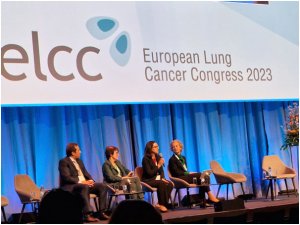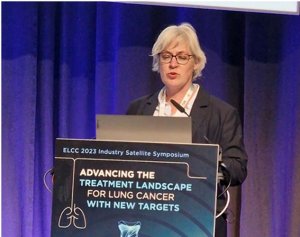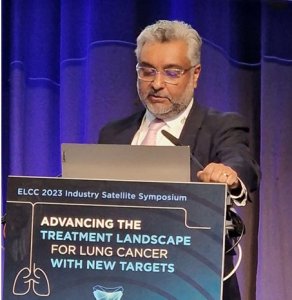- Advancing the Treatment Landscape for Lung Cancer with New Targets
- By Innocent Fowung (UK Correspondent)
The European Lung Cancer Congress (ELCC2023) met recently in Copenhagen, Denmark from March 28th – 1st April, bringing together multidisciplinary societies representing thoracic oncology specialists, through joint efforts to advance the treatment landscape for lung cancer (L/C), disseminate education and improve the practice of lung cancer specialists worldwide. Specialities were drawn from Medical Oncologists, Radiation Oncologists, Thoracic Surgeons, Respiratory Physicians/Pulmonologists, Interventional Radiologists and Pathologists, all came together to share their expertise on lung cancer.The congress core mission was to improve the quality of cancer care, from prevention and diagnosis all the way to palliative care and patient following up. The congress also aimed at educating doctors, cancer patients and the general public on the best practices and latest advances on oncology. Participants brought in their expertise on the best care to people with lung cancer, through fostering integrated cancer care, supporting oncologists in their professional development, and advocating for sustainable cancer care worldwide.

In conjunction with the annual congress of European Association for Cancer Research (EACR), this congress was to provide an insight into the prevention, diagnosis, biology and multidisciplinary management of thoracic malignancies. The congress included specifically educational and scientific sessions covering:
- Prevention, screening and early diagnosis of thoracic tumours;
- Recent development s on molecular diagnosis and therapeutic classes for lung cancer;
- New challenges and opportunities with immune targeted therapies;
- The evolving role of multimodality and multidisciplinary decisions in lung cancer;
- State of the art for NSCLC, SCLC, mesothelioma and mediastinal tumours.
Presentations at the congress included topics such as tobacco and cancer, air pollution and cancer, chemical and lung cancer, diagnosis, prevention and treatment of lung cancer, and many more.

Lung cancer continues to be the leading cause of death in both men and women worldwide; killing over 1 million people a year. Extensive epidemiology data clearly associates cigarette smoking as a major cause of lung cancer. In the United State of America (USA) for example, it is estimated that about 75-80% of lung cancer deaths each year is caused by smoking (Hecht, 1999). Lung cancer has become an important and widespread disease that constitutes a major public health problem; a disease which was extremely rare some 150 years ago.
Air pollution has also been mentioned as another cause of lung cancer; the existence of a city-rural gradient in lung cancer incidence was strongly suggestive. It has also been reported that chemicals encounter in certain occupations could cause lung cancer: arsenic containing compounds in wine growers, asbestos, nickel and chromium in mine and smelter workers.
LUNG CANCER RISKS
According to Cancer Research UK, a person’s risk of developing lung cancer depends on many factors, including age, genetics, and exposures to risks factors (including some potentially avoidable lifestyle factors). A question posed by Dr. Navneet Singh, a professor of pulmonary medicine and faculty in-charge of lung cancer, India: “does quantification of tobacco smoke exposure provides a common link?”
Prof. Singh carried out 2 studies on smokers, non-smokers (KRAS-G12C Mutated NSCLC). The study looked at risk of lung cancer among current smokers by Pack year smoking ( a Cohort studies with 23 years follow-up). The study included 500 current smokers with 23 years follow-up. Some patients who quit after 15 years of smoking, the incident of lung cancer were similar to those who carried on smoking. Key facts/issues arising from this study includes; earliest identification as strong risk factor, Causation established by longitudinal studies, influences not just development of lung cancer (risk) but also disease characteristics at presentation and outcomes, quantification of tobacco smoke exposure easier in regions where cigarettes dominate (pack years).

The role of smoking as causative agent had been firmly established. According to a case control study carried in Germany in 1940, the publication stated that “the extraordinary rise in tobacco use was the single most important cause of the rising incidence of lung cancer” (Muller, 1940).
Further evidence from other studies carried out globally has also cited causal association between smoking and lung cancer. Figures published on 27 countries in Europe (EU) in 2020, lung cancer accounted for 11.9% of all new cancer diagnosis, and 20.4% of all deaths due to cancer.
How can lung cancer prevention and treatment strategies be improved in resource-restricted settings?
The key to overcoming barriers to effective prevention and treatment in resource-restricted settings involves cooperation between multiple organisations, including medical societies, patient groups, pharmaceutical companies and regulatory agencies
According to global cancer statistics from 2020, lung cancer is the leading cause of cancer death, accounting for an estimated 18% of all deaths from cancer worldwide. While these latest figures point to three- or four-fold higher lung cancer incidence and mortality rates in higher-income nations, low- and middle-income countries are anticipated to have increasingly higher corresponding rates in the coming years, largely because of a rise in tobacco smoking.
Screening and early diagnosis is important to give patients the best outcomes for most cancers, including lung cancer. However, lung cancer screening programmes require a healthcare system with complex infrastructure and considerable economic resources and consequently, there is disparity between countries in the availability of such programmes.
Participants looked at screening for lung cancer as being helpful if all the components of care are available and affordable, such as safe, effective, high-quality treatments. A study carried out by European Society for Medical Oncology (ESMO) International Consortium on the availability, out-of-pocket costs and accessibility of anti neoplastic medicines in countries outside of Europe, published in 2017, identified between-country discrepancies in availability resources, and including medically necessary anticancer medicines registered in the Wealth Health Model list of Essential Medicines for cancer. The most profound issues relating to out-of-pocket costs and a lack of availability of essential cancer medicines were in low- and middle-income countries.
The congress generalised patients in low- and middle-income countries as having no access to the newest and most expensive drugs that are standard of care in high-income countries. Such barriers to the availability of newer agents include a lack of molecular companion diagnostic tests for use prior to targeted agents, as has been identified in some Southeast Asian countries for EGFR-targeting treatments for non-small-cell lung cancer. Reimbursement of medicines also varies, as reported recently in a study of medicines to treat advanced lung cancer in Brazil, in which the cost estimate of the best treatment available was much higher than the amount reimbursed by the country’s public health system, making the treatment unaffordable and potentially leading to inferior survival outcomes.
One of the key questions asked at the congress was such: “what can be done to improve the availability of effective lung cancer medicines for all?” In response to this question, the key aspect is to stimulate productive dialogue between medical societies, patient groups, governments, the pharmaceutical industry and regulatory agencies to shorten approval and registration times for new medicines and expand access to timely molecular testing. In addition, medical experts in the treatment of lung cancer all need to work towards improved affordability, which may be achieved through a multi-pronged approach including strengthening pricing policies at the national and regional levels, and enhancing the efficiency of the expenditure on medicines. Congress participants concluded that it is their share responsibility to improve future access to effective healthcare for a greater number of patients.
KEY TAKE-AWAY MESSAGE
Key take home message came from Professor Anne-Marie Dingemans (Respiratory physician) – Uranus University Medical Centre, Rotterdam in the Netherlands; Professor Sanjay Popat – Consultant Medical Oncologist, Royal Marsden Hospital, Institute of Cancer Research, London, United Kingdom; Dr. Herve Lana (Oncologist from France), Dr Fiona Blackhall from The Christie NHS Foundation Trust, United Kingdom, among others, all agreed that tobacco smoking is far the most important risk factors in the development of lung cancer. Today, lung cancer is the biggest cancer killer in Europe, accounting for 20.8% of all cancers deaths. Therefore, smoking cessation programs should remain an important aspect of the long-term efforts in reducing the incidence of lung cancer.
Another important goal from the congress was agreed by participants to delay tumour relapse (living without disease), reduce tumour-related symptoms, transform advanced stage into amendable for curative intent. Tobacco smoking should continue to be pursued at all levels – global, regional and country with the active involvement and efforts of all concerned (government and NGOs; patient advocacy groups and health care professionals). Quantified tobacco smoke exposure should be an integral part of future trials; QTSE may turn out to be a (sample+ve/-ve) predictor factor for treatment (RX) efficacy. Increasing incidence of lung cancer in light with never smokers cannot be ignored, as well as increase the ability of L/C screening in both underrepresented individual groups (current smokers as well as light/never smokers).
Professor Anne-Marie Dingemans (Respiratory physician) – Uranus University Medical Centre, Rotterdam in the Netherlands
Some Congress Presenters discussing ways of improving the treatment lung cancer
Professor Sanjay Popat – Consultant Medical Oncologist, Royal Marsden Hospital, Institute of Cancer Research, London, United Kingdom